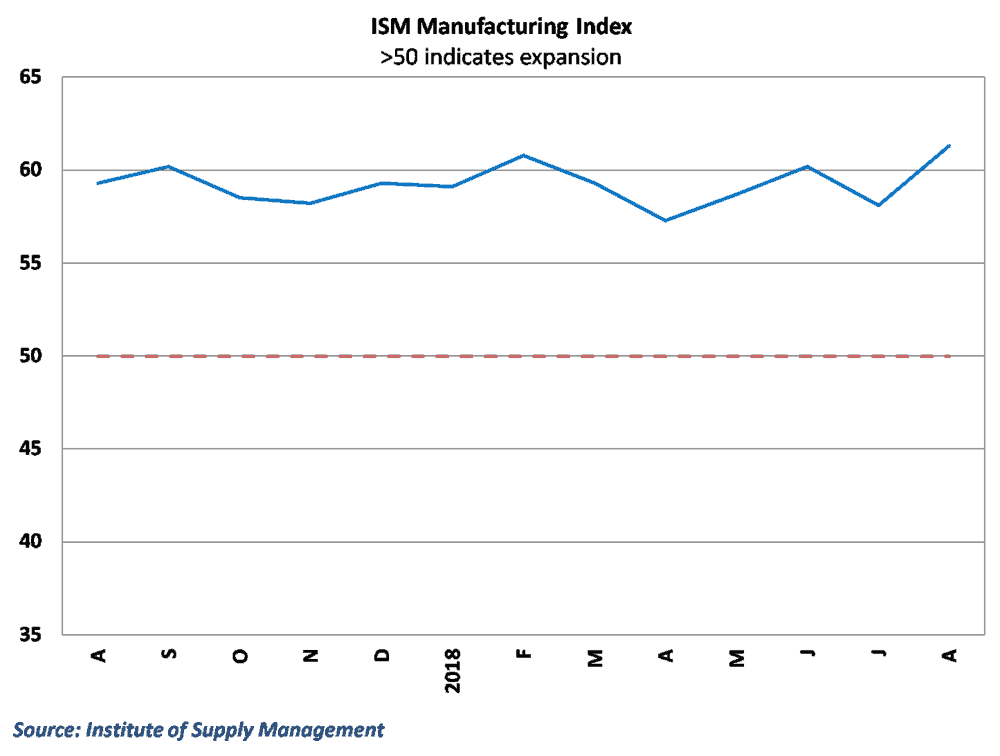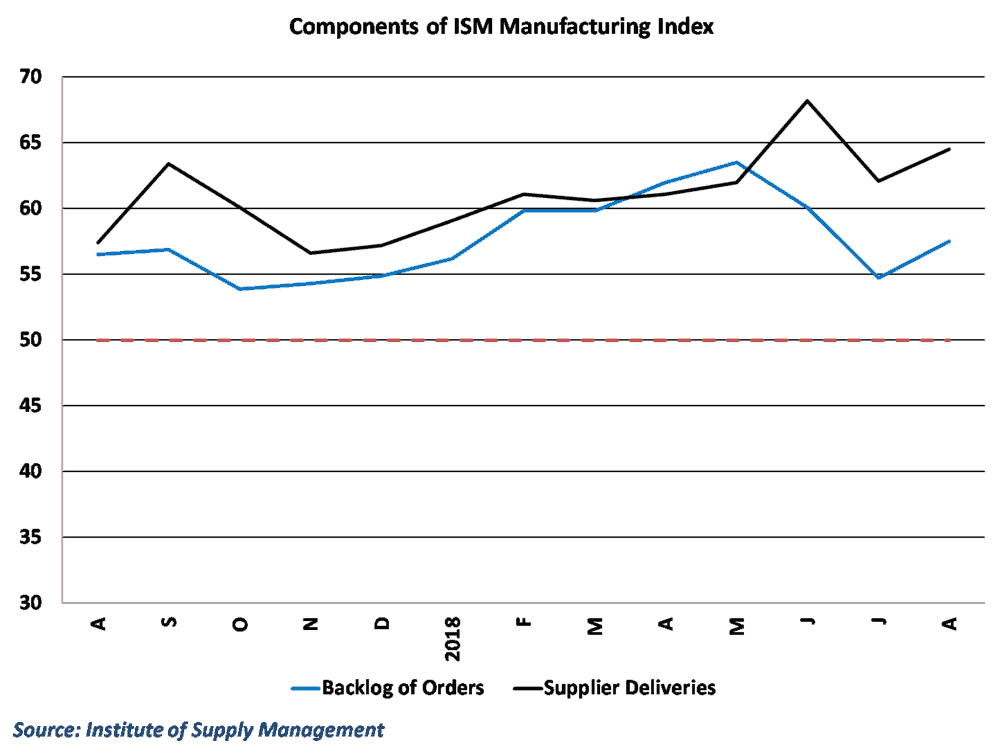
Survey data from the manufacturing sector improved significantly in August, in a sign that activity continues at a strong pace after robust growth in the 2nd quarter.

Data from the Institute of Supply Management (ISM) showed that US factory activity expanded at a faster pace in August, as the manufacturing purchasing managers index jumped to 61.3 from 58.1 in the previous month. This far exceeded consensus expectations of a slight decline to 57.7 and marks the highest reading of the composite index since May of 2004. The New Orders and Production components of the index both saw large increases during the month, signaling that demand remains abnormally high in the 3rd quarter and is likely to remain strong going forward.
Backlogs and slow supplier deliveries continue, indicating bottlenecks in the production process

Details within the ISM report help to shed some insight into the state of freight markets during the month. The Supplier Deliveries index measures how long it taking for manufacturers to receive materials for production from their suppliers, with higher values indicating longer delivery times. This subcomponent has increased steadily over the past year, as capacity constraints within the freight industry have led to additional delays in the production process. This has created some bottlenecks in the production process, and is likely keeping actual production from being even higher than it already is.
Evidence of this can be seen in the manufacturing Backlog of Orders component within the ISM data. Higher values here indicate a rising number of orders that manufacturers cannot fill during the current period, and serve as an indication of the ability for businesses to fulfill demand. Like Supplier Deliveries, order backlogs have been at elevated levels throughout the past year.
Both Supplier Deliveries and Backlog of Orders increased in August. While each has moderated since reaching 10+ year highs in the 2nd quarter, they remain well above the levels seen at this point last year and point to a manufacturing sector that is having a difficult time keeping up with all of the demand in the economy.
Tariffs continue to loom over robust activity
As has been the case since being announced earlier in the year, tariffs remain one of the chief concerns facing manufacturers in the economy. The announcement and subsequent implementation of tariffs on steel and aluminum led to a surge in prices of these metals in the immediate aftermath, and recent tariffs on Chinese goods threaten to affect a number of downstream industries in the US.
Respondents in the ISM survey again called attention to the effect that these moves are having on business. One respondent in the Petroleum and Coal industry noted: “Steel tariffs and their threats are putting upward pressure on downstream materials.”
It is becoming clear, however, that whatever impact these tariffs are having is not enough to derail a generally favorable environment. One participant from the Fabricated Metals industry summed up the general threat of tariffs succinctly: ““The toughest thing we deal with is the unknown. Dealing with tariffs on steel purchases and not knowing if or when they will end makes planning difficult. We are entering the period when we begin our pricing negotiations for next year and will likely treat the tariffs as if they will be here for the entire year. It’s challenging, but not insurmountable.”
About the ISM Index
Each month, the Institute of Supply Management surveys purchasing managers in the manufacturing and service sectors on different aspects of business, asking whether or not their activity is expanding or contracting. Data is collected on things such as employment, production, prices, exports, inventories, and orders. Responses are then weighted to create the ISM manufacturing and nonmanufacturing indices.
Readings above 50 signal that more than half of the respondents to the survey believe that overall manufacturing activity is expanding during the month, while readings below 50 are a sign that activity is contracting. Historically, index results over 55 are a sign of above-trend growth in the manufacturing sector.
ISM data also gives some insight into trucking freight conditions. Manufacturing production is one of the key supports for freight demand in the economy, and readings from the ISM index typically are a leading indication on the amount of truck tonnage growth in trucking markets.
Behind the Numbers
This month’s ISM report serves as a useful reminder that one of the key drivers of freight demand remains on strong footing into the 3rd quarter. ISM readings usually line up nicely with industrial production output which gets released mid-month, so expect some solid numbers for August production when it is announced. There are some weak spots from the freight demand perspective, but manufacturing is not one of them.
As is usually the case, the survey responses were as insightful as the headline number itself. We have been saying for a while here that the impact of tariffs is likely not enough to cause any serious reduction in growth in the economy. Some industries are going to feel the effects more than others, but overall it appears that manufacturers are realizing that the current trade spats are nothing that cannot be overcome. As long as consumer spending, business investment, and global export demand remain strong, manufacturing will likely follow.
Ibrahiim Bayaan is FreightWaves’ Chief Economist. He writes regularly on all aspects of the economy and provides context with original research and analytics on freight market trends. Never miss his commentary by subscribing.










